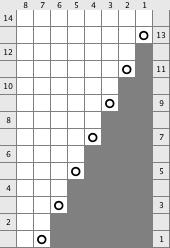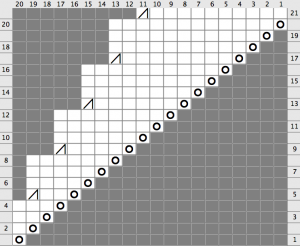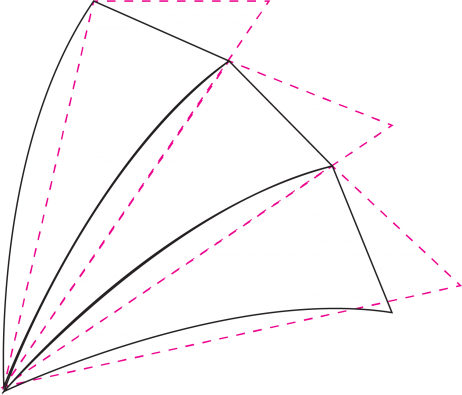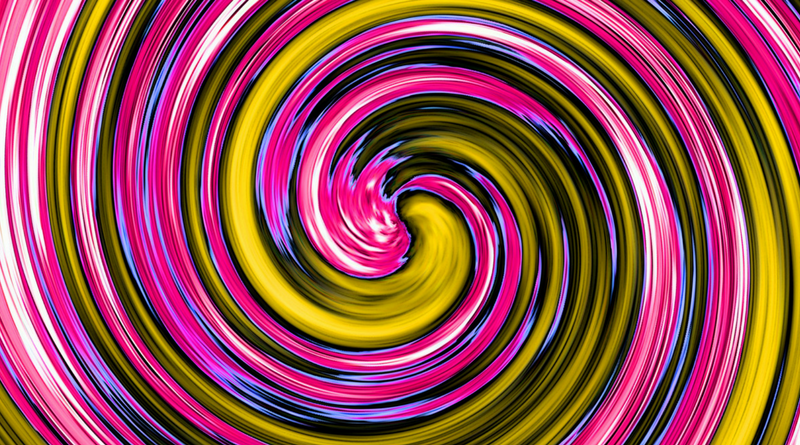The Ultimate Guide to Knitting Vortex Shawls
There are so many vortex shawl patterns out there recently but nobody seems to really understand how this all works. What shapes a vortex? Or even: What the heck is a vortex anyway?
What Are Vortex Shawls?
In fluid dynamics, a vortex is a region in a fluid in which the flow is rotating around an axis line, which may be straight or curved. The plural of vortex is either vortices or vortexes.

Translated to knitting, vortices are a kind of curved triangles. It’s basically a part of a true vortex, but let’s call them vortex shawls to avoid obscurity.

The Construction of Vortex Shawls
Vortex shawls are best started from the tip. Cast on a few stitches and knit away, following the construction principle of vortex shawls: it’s all about asymmetrical increases!
Vortices are triangles but shaped by asynchronous asymmetrical increases, which means to increase more stitches on one side of the triangle than the other- but not regularly.
No idea what I’m talking about? Let’s start simple.
Vortex shawls are based on are triangles worked sideways. Starting with a few stitches (say, three) we increase regularly but on one side only – the result is a triangle. If we increase one stitch every other row the resulting angle of this triangle is approximately 45°, depending on your gauge.

We want a vortex shape not a triangle so we need additional decreases on the left edge. Decreasing regularly (as shown below) is the next logical step. In the picture below additional decreases are worked on the left edge of our triangle, resulting in a kind of distorted triangle shape.

The trick forming a vortex shawl from this distorted triangle is to decrease asynchronously. In the picture above we increase one stitch every row and decrease one stitch every other row. What we need to shape a vortex is to decrease more stitches at once: two stitches every fourth row, or three stitches every sixth row for instance, still based on one increase per row on the right edge as shown in the picture below.

When working a vortex we increase continually on one side (e.g. increase one stitch every row) and decrease a certain amount of stitches at certain points (e.g. decrease three stitches every sixth row).
In our example we increase one stitch every row and decrease three every sixth row. In total, we increase three stitches in six rows. The trick is to do it asynchronously!
Pattern Template: Vortex Shawls
- CO 5 sts and purl one row.
- Next Row (RS): K1, YO, k to end of row.
- Next Row (WS): K to last stitch, YO, k1.
- Repeat the last two rows 2 times more.
- Next Row: K1, k4tog, k to last stitch, YO, k1.
- Repeat the last six rows until shawl is of desired size.
How Does the Vortex Shape Get Its Shape?
Question of the day: “How do you achieve a vortex shape in shawl knitting?”
Well, the answer is simple: by introducing asymmetrical decreases on one edge of the shawl. But this answer actually raises more questions: why the heck is that?
What Turns A Triangle Into a Vortex Panel?
I tried to answer this question in detail while working on the chapter on vortex and swirl shawls of Shawl Design in Plain English: Fancy Shawl Shapes: the key to vortex panels are asynchronous increases.
Assume we are knitting a vortex shawl with the following parameters: one increase every row combined with three bound off stitches every sixth row. This results in a total of one stitch increased every second row. (6 – 3 = 3 total stitches increased in 6 rows (1 in 6), cancelling out results 1 stitch increased every second row – 1 in 2).
Theoretically, it should look like shown below. (Gray: normal stitches, green: increased stitches, magenta: decreased / bound off stitches).

But it does not. The result is a vortex. Why? Because we are not knitting vertically! The actual knitting direction is an arc, as shown below.

This is what turns a triangle into a vortex. The knitting direction as shown above (the black arrow).
The shape shown above is the basis for each and every vortex shawl and swirl shawl. More than one of this shapes can be combined, and if the number of panels is matched against the increase angle, a swirl shawl (a circular shawl in fact, but with a different construction method as described in Shawl Design for Everybody: Circular Shawls).
Combinations of Vortex Panels: Fans and Swirl Shawls
If some vortex panels are combined, fan-like shapes are the result.

Swirl Shawls: How Many Panels?
When it comes to swirl shawls, it’s very important to match the increase angle with the number of vortex panels worked in the round.
Details are provided in the volume three of my book Shawl Design in Plain English: Fancy Shawl Shapes.
Any more questions? I’m happy to hear them!
Is This Really the World’s First Guide to Knitting Vortex Shawls?
I can hardly believe this is true but it seems nobody has written a guide to vortex shawls before. Did you find one? Let me know by leaving a comment below!


Hi,very interesting informations. Thank you for your effort. I want to knit it on my knitting machine. I was thinking where on it to start not to be forced to move all the stitches.
Sadly I have no experience with knitting machines (always wanted to give them a try!) so unfortunately I’m not in the position to gove any helpful advice. Let us know if you found out!
I believe there are still errors in the instructions.
Shouldn’t “Next row: k1…” be the 6th row of the 6th row repeat? Shouldn’t it be a WS row? Shouldn’t it be purled?
Pingback: Ein Tuch aus zartem Mohair – Lavendelhexe.net
Would you believe your vortex shawl pattern caught my husband’s eye! I’m quite a rookie w/ directions and I’m puzzled by your initial directions….after CO 5 & purling 1 row….I can’t figure out how the 6 row repeat works out…(RS) Row 1, (WS) Row 2, 3 says repeat Rows 1 & 2 twice, and Row 4…..Repeat last 6 rows….R 1, R 2 & R 4 =3….but the 2 repeats of R 1 & R 2 adds 4…..4+3 = 7 rows…..I’m sure I’m missing something and would appreciate your help.
Pingback: Shawl Shapes Overview 2019: Julia's New Shawl Design Cheatsheet
Pingback: How to Knit Boomerang Shawls - knitting.today
Is A swirl shawl also Started as a vortex, I started A vortex and wanted to change the way of knitting to get A swirl shawl, when I realised that isn’t possible.
Hoe to lose this problem?
A swirl shawl is made of several vortices.
I’m having the same confusion about where the increases go – shouldn’t it be increase at beginning of RS rows and and increase at the end of WS rows? And then decrease at the beginning of a last WS row?
Thanks for your comment! The article has been updated.
I cannot understand what the last 6 rows are. Please help me.
I absolutely love that purple vortex shawl diagram. I’m fairly new to knitting and have a hard time visualizing a pattern without every detail mapped out. Do you have a pattern specific to that triangle vortex shawl I could purchase? Thanks!
Thanks so much for the Vortex explanation. I’d like to knit a vortex shawl.
I got ‘one’ vortex triangle. Do I have to start knitting another triangle? How?
Continue knitting the same way
I’m not sure I understand the instructions. It says to increase at the start of each row, but to get all of the increases on one side (as in the chart), wouldn’t you increase at the start of RS rows and the END of WS rows?
Never mind!! I need more caffeine this morning!
I simply cannot understand this pattern! I know how to start out, but when it’s saying to k4tog, and ‘knit last 6 rows, I am lost! What does ‘k4tog’ mean? And what are ‘the last 6 rows’ that you speak about?
“k4tog” means “knit 4 stitches together”, and the last six rows are … well, the last six rows of your knitting at this point.
Pingback: Ein Tuch aus zartem Mohair | Lavendelhexe
Thank you so much for your explanation. Light bulbs are flashing in my brain! I have always just followed such shawl patterns blindly, thinking the designer was a true wizard. I still think they are wizards, but now it makes sense too.
Pingback: The Making of the Plant Anatomy Shawl Pattern Collection
I am knitting the vortex shawl , but Pattern is increasing in one way, without curves on the other side. Any suggestions to repairing? Pls not knit again at the starts!
Are you increasing asymmetrically? This is the main reason for troubles with vortices.
Pingback: Shawl Design for Everybody - Your Free Shawl Design Online Course
Hope I will succeed too ! Tanks a lot for explanations
I do not understand your vortex shawl template pattern above. Whdn you state ‘repeat last row 3 more times’ do you mean the last two rows?
To me,the last row referenced is the row that says to knit. Thanks!
Kathy, I corrected the mistake – thank you!
Thank you for taking time to write this info up ! I’m a beginner knitter and I find this very informative , and now I’m more confident to try one out 🙂
My pleasure!
this looks to me like a black hole shawl and would be very popular among astronaut oriented kids.
hm